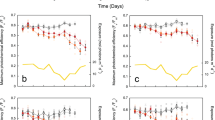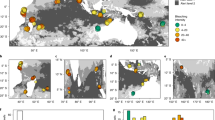Abstract
Rising sea temperatures are likely to increase the frequency of disease outbreaks affecting reef-building corals through impacts on coral hosts and pathogens. We present and compare climate model projections of temperature conditions that will increase coral susceptibility to disease, pathogen abundance and pathogen virulence. Both moderate (RCP 4.5) and fossil fuel aggressive (RCP 8.5) emissions scenarios are examined. We also compare projections for the onset of disease-conducive conditions and severe annual coral bleaching, and produce a disease risk summary that combines climate stress with stress caused by local human activities. There is great spatial variation in the projections, both among and within the major ocean basins, in conditions favouring disease development. Our results indicate that disease is as likely to cause coral mortality as bleaching in the coming decades. These projections identify priority locations to reduce stress caused by local human activities and test management interventions to reduce disease impacts.
This is a preview of subscription content, access via your institution
Access options
Subscribe to this journal
Receive 12 print issues and online access
$209.00 per year
only $17.42 per issue
Buy this article
- Purchase on Springer Link
- Instant access to full article PDF
Prices may be subject to local taxes which are calculated during checkout




Similar content being viewed by others
References
National Climatic Data Center State of the Climate (US National Oceanic and Atmospheric Administration, 2014); http://www.ncdc.noaa.gov/sotc/global/2014/8
Slezak, M. Oceans get into hot water. New Sci. 224, 8–9 (2014).
Hewson, I. et al. Densovirus associated with sea-star wasting disease and mass mortality. Proc. Natl Acad. Sci. USA 111, 17278–17283 (2014).
Groner, M. L. et al. Host demography influences the prevalence and severity of eelgrass wasting disease. Dis. Aquat. Org. 108, 165–175 (2014).
Savary, S., Nelson, A., Sparks, A. H. & Willocquet, L. International agricultural research tackling the effects of global and climate changes on plant diseases in the developing world. Plant Dis. 95, 1204–1216 (2011).
Garrett, K. A., Dendy, S. P. & Frank, E. E. Climate change effects on plant disease: Genomes to ecosystems. Annu. Rev. Phytopathol. 44, 489–509 (2006).
Altizer, S., Ostfeld, R. S., Johnson, P. T. J., Kutz, S. & Harvell, C. D. Climate change and infectious diseases: From evidence to a predictive framework. Science 341, 514–519 (2013).
Rogers, D. J. & Randolph, S. E. The global spread of malaria in a future, warmer world. Science 289, 1763–1766 (2000).
van Lieshout, M., Kovats, R. S., Livermore, M. T. J. & Martens, P. Climate change and malaria: Analysis of the SRES climate and socio-economic scenarios. Glob. Environ. Change 14, 87–99 (2004).
Béguin, A. et al. The opposing effects of climate change and socio-economic development on the global distribution of malaria. Glob. Environ. Change 21, 1209–1214 (2011).
Ruiz-Moreno, D., Vargas, I. S., Olson, K. E. & Harrington, L. C. Modeling dynamic introduction of Chikungunya virus in the United States. PLoS Negl. Trop. Dis. 6, e1918 (2012).
Burge, C. A. et al. Climate change influences on marine infectious diseases: Implications for management and society. Annu. Rev. Mar. Sci. 6, 249–277 (2014).
Bruno, J. F., Selig, E. R., Casey, K. S., Page, C. A. & Willis, B. L. Thermal stress and coral cover as drivers of coral disease outbreaks. PLoS Biol. 5, e124 (2007).
Miller, J. et al. Coral disease following massive bleaching in 2005 causes 60% decline in coral cover on reefs in the US Virgin Islands. Coral Reefs 28, 925–937 (2009).
Harvell, D., Altizer, S., Cattadori, I. M., Harrington, L. & Weil, E. Climate change and wildlife diseases: When does the host matter the most? Ecology 90, 912–920 (2009).
Harvell, D., Jordán-Dahlgren, E. & Merkel, S. Coral disease, environmental drivers, and the balance between coral and microbial associates. Oceanography 20, 172–195 (2007).
Sato, Y., Bourne, D. G. & Willis, B. L. Dynamics of seasonal outbreaks of black band disease in an assemblage of Montipora species at Pelorus Island (Great Barrier Reef, Australia). Proc. Biol. Sci. 276, 2795–2803 (2009).
Riegl, B. Effects of the 1996 and 1998 positive sea-surface temperature anomalies on corals, coral diseases and fish in the Arabian Gulf (Dubai, UAE). Mar. Biol. 140, 29–40 (2002).
Cervino, J. M. et al. Relationship of Vibrio species infection and elevated temperatures to yellow blotch/band disease in Caribbean corals. Appl. Environ. Microbiol. 70, 6855–6864 (2004).
Heron, S. F. et al. Summer hot snaps and winter conditions: Modelling white syndrome outbreaks on Great Barrier Reef Corals. PLoS ONE 5, e12210 (2010).
Maynard, J. A. et al. Predicting outbreaks of a climate-driven coral disease in the Great Barrier Reef. Coral Reefs 30, 485–495 (2010).
van Vuuren, D. P. et al. The representative concentration pathways: An overview. Climatic Change 109, 5–31 (2011).
van Hooidonk, R. J., Maynard, J. A., Manzello, D. & Planes, S. Opposite latitudinal gradients in projected ocean acidification and bleaching impacts on coral reefs. Glob. Change Biol. 20, 103–112 (2014).
Aeby, G. S. et al. Patterns of Coral Disease across the Hawaiian Archipelago: Relating disease to environment. PLoS ONE 6, e20370 (2011).
Lamb, J. B. & Willis, B. L. Using coral disease prevalence to assess the effects of concentrating tourism activities on offshore reefs in a tropical marine park. Conserv. Biol. 25, 1044–1052 (2011).
Vega Thurber, R. L. et al. Chronic nutrient enrichment increases prevalence and severity of coral disease and bleaching. Glob. Change Biol. 20, 544–554 (2013).
Pollock, F. J. et al. Sediment and turbidity associated with offshore dredging increase coral disease prevalence on nearby reefs. PLoS ONE 9, e102498 (2014).
Burke, L. M., Reytar, K., Spalding, M. & Perry, A. Reefs at Risk Revisited (World Resources Institute, 2011).
Kline, D. I., Kuntz, N. M. & Breitbart, M. Role of elevated organic carbon levels and microbial activity in coral mortality. Mar. Ecol. 314, 119–125 (2006).
Bruno, J. F., Petes, L. E., Drew Harvell, C. & Hettinger, A. Nutrient enrichment can increase the severity of coral diseases. Ecol. Lett. 6, 1056–1061 (2003).
Haapkylä, J. et al. Seasonal rainfall and Runoff promote coral disease on an inshore reef. PLoS ONE 6, e16893 (2011).
Sutherland, K. P., Shaban, S., Joyner, J. L., Porter, J. W. & Lipp, E. K. Human pathogen shown to cause disease in the threatened Eklhorn Coral Acropora palmata. PLoS ONE 6, e23468 (2011).
Lamb, J. B., True, J. D., Piromvaragorn, S. & Willis, B. L. Scuba diving damage and intensity of tourist activities increases coral disease prevalence. Biol. Conserv. 178, 88–96 (2014).
Hawkins, J. P. et al. Effects of recreational scuba diving on Caribbean coral and fish communities. Conserv. Biol. 13, 888–897 (1999).
Miller, M. W. & Williams, D. E. Coral disease outbreak at Navassa, a remote Caribbean island. Coral Reefs 26, 97–101 (2007).
Bruckner, A. W. & Bruckner, R. J. Outbreak of coral disease in Puerto Rico. Coral Reefs 16, 260 (1997).
Nicolet, K., Hoogenboom, M., Gardiner, N., Pratchett, M. & Willis, B. The corallivorous invertebrate Drupella aids in transmission of brown band disease on the Great Barrier Reef. Coral Reefs 32, 585–595 (2013).
Katz, S. M., Pollock, F. J., Bourne, D. G. & Willis, B. L. Crown-of-thorns starfish predation and physical injuries promote brown band disease on corals. Coral Reefs 33, 705–716 (2014).
Aeby, G. S. & Santavy, D. L. Factors affecting susceptibility of the coral Montastraea faveolata to black-band disease. Mar. Ecol. Prog. Ser. 318, 103–110 (2006).
Casey, J. M., Ainsworth, T. D., Choat, J. H. & Connolly, S. R. Farming behaviour of reef fishes increases the prevalence of coral disease associated microbes and black band disease. Proc. R. Soc. B 281, 20141032 (2014).
Knutti, R. & Sedláček, J. Robustness and uncertainties in the new CMIP5 climate model projections. Nature Clim. Change 3, 369–373 (2012).
van Hooidonk, R. & Huber, M. Effects of modeled tropical sea surface temperature variability on coral reef bleaching predictions. Coral Reefs 31, 121–131 (2012).
Cróquer, A. & Weil, E. Changes in Caribbean coral disease prevalence after the 2005 bleaching event. Dis. Aquat. Org. 87, 33–43 (2009).
Aeby, G. S., Ross, M., Williams, G. J., Lewis, T. D. & Work, T. M. Disease dynamics of Montipora white syndrome within Kaneohe Bay, Oahu, Hawaii: Distribution, seasonality, virulence, and transmissibility. Dis. Aquat. Org. 91, 1–8 (2010).
Beeden, R., Maynard, J. A., Marshall, P. A., Heron, S. F. & Willis, B. L. A framework for responding to coral disease outbreaks that facilitates adaptive management. Environ. Manag. 49, 1–13 (2012).
Maynard, J. A. et al. A strategic framework for responding to coral bleaching events in a changing climate. Environ. Manag. 44, 1–11 (2009).
Williams, G. J., Aeby, G. S., Cowie, R. O. & Davy, S. K. Predictive modeling of coral disease distribution within a reef system. PLoS ONE 5, e9264 (2010).
van Hooidonk, R., Maynard, J. A. & Planes, S. Temporary refugia for coral reefs in a warming world. Nature Clim. Change 3, 1–4 (2013).
Miller, J., Waara, R., Muller, E. & Rogers, C. Coral bleaching and disease combine to cause extensive mortality on reefs in US Virgin Islands. Coral Reefs 25, 418 (2006).
Brandt, M. & McManus, J. Disease incidence is related to bleaching extent in reef-building corals. Ecology 90, 2859–2867 (2009).
Muller, E. M., Rogers, C. S., Spitzack, A. S. & VanWoesik, R. Bleaching increases likelihood of disease on Acropora palmata (Lamarck) in Hawksnest Bay, St John, US Virgin Islands. Coral Reefs 27, 191–195 (2008).
van Hooidonk, R. & Huber, M. Quantifying the quality of coral bleaching predictions. Coral Reefs 28, 579–587 (2009).
Acknowledgements
This study was primarily funded by a grant from the National Oceanic and Atmospheric Administration (NOAA) Climate Program Office prepared by S.F.H. and awarded to C.D.H. and C.M.E. (NA13OAR4310127). Support was also provided by a National Science Foundation Research Coordination Network grant to C.D.H., in-kind support from NOAA Atlantic and Oceanographic Meteorological Laboratory, as well as grants from the NOAA Coral Reef Conservation Program, the US National Fish and Wildlife Foundation, the Pacific Islands Climate Change Cooperative, the European Research Commission, and The Nature Conservancy. Use of data from ref. 28 benefited from discussions with L. Burke and K. Reytar. Figures were collaboratively developed with D. Tracey. The contents in this manuscript are solely the opinions of the authors and do not constitute a statement of policy, decision or position on behalf of the NOAA or the US Government.
Author information
Authors and Affiliations
Contributions
J.M., C.D.H., C.M.E., S.F.H., R.v.H., B.W., M.G., J.L. and G.W. designed the study. R.v.H. compiled and analysed the climate model data in collaboration with J.M. M.P. conducted the spatial analysis required to build the maps on which Figs 3 and 4 and Supplementary Figs 1 and 2 are based, in collaboration with J.M. J.M., C.D.H., C.M.E. and B.W. wrote the manuscript with assistance from all other authors.
Corresponding author
Ethics declarations
Competing interests
The authors declare no competing financial interests.
Supplementary information
Rights and permissions
About this article
Cite this article
Maynard, J., van Hooidonk, R., Eakin, C. et al. Projections of climate conditions that increase coral disease susceptibility and pathogen abundance and virulence. Nature Clim Change 5, 688–694 (2015). https://doi.org/10.1038/nclimate2625
Received:
Accepted:
Published:
Issue Date:
DOI: https://doi.org/10.1038/nclimate2625
This article is cited by
-
Systematic review of the uncertainty of coral reef futures under climate change
Nature Communications (2024)
-
The role and risks of selective adaptation in extreme coral habitats
Nature Communications (2023)
-
Disturbance intensification is altering the trait composition of Caribbean reefs, locking them into a low functioning state
Scientific Reports (2023)
-
Coral and Seawater Metagenomes Reveal Key Microbial Functions to Coral Health and Ecosystem Functioning Shaped at Reef Scale
Microbial Ecology (2023)
-
Physiological acclimatization in Hawaiian corals following a 22-month shift in baseline seawater temperature and pH
Scientific Reports (2022)



